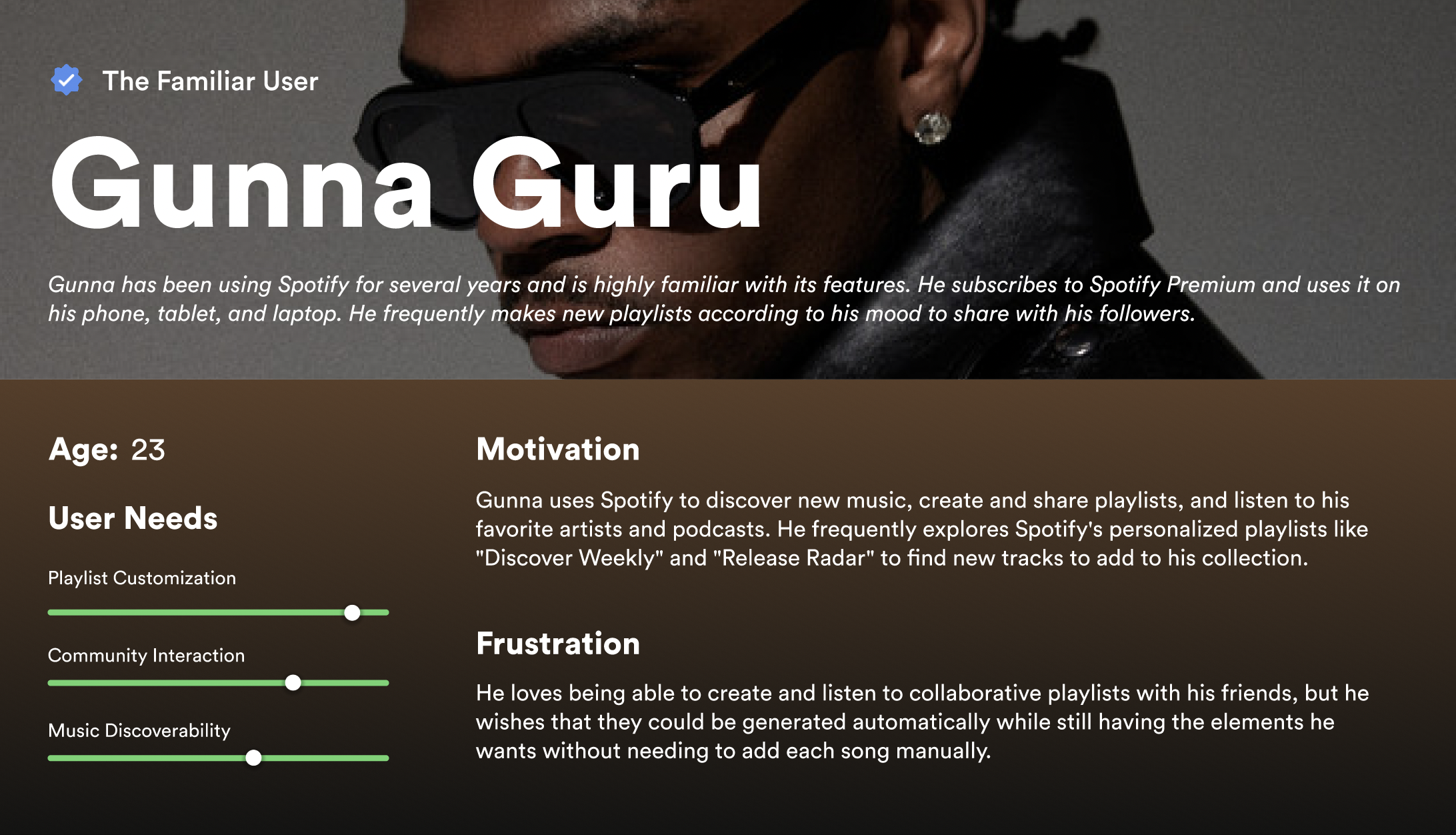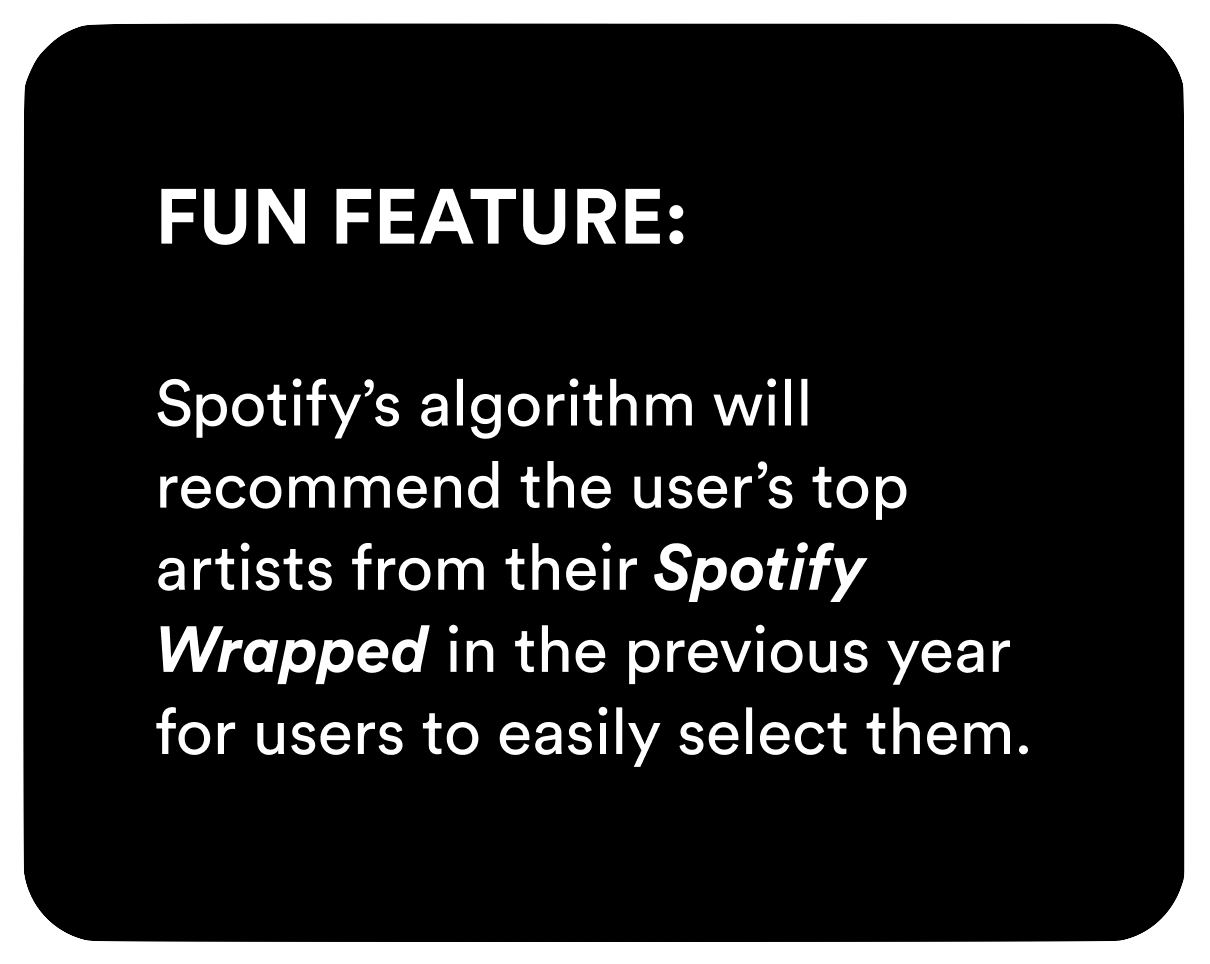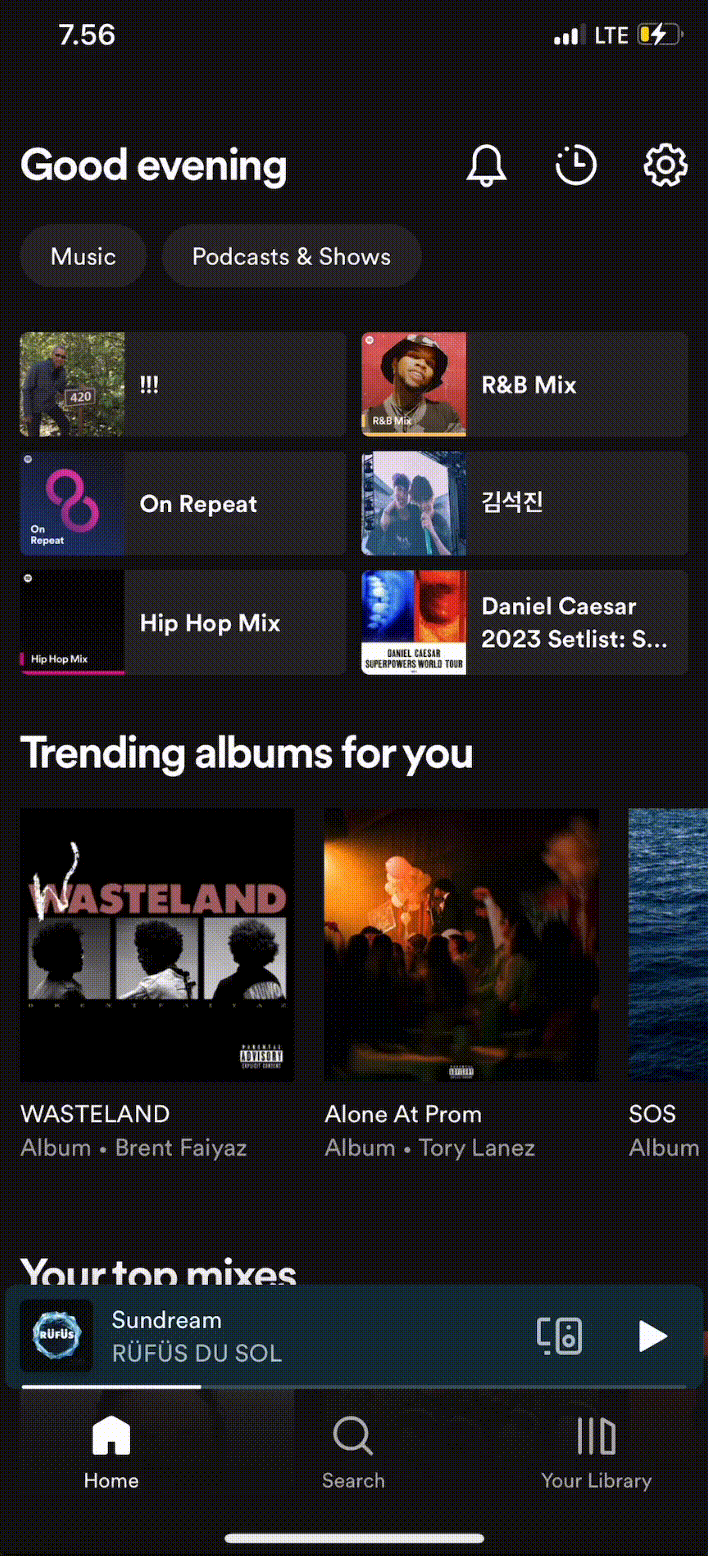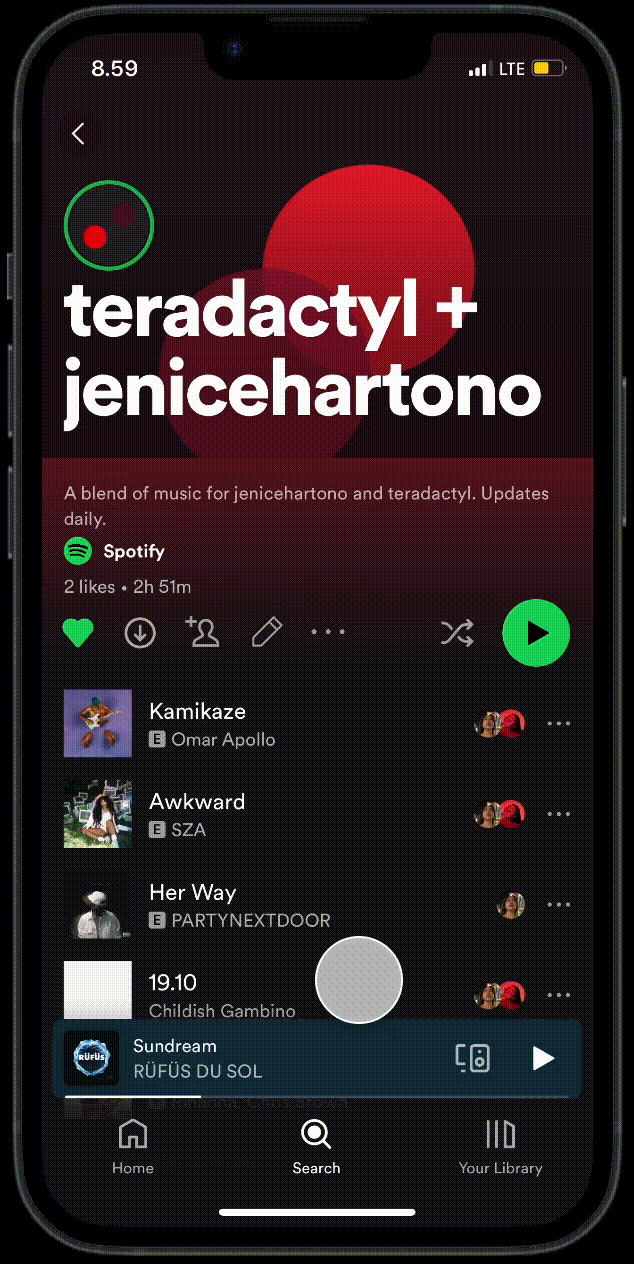PROJECT
Case study
TIMELINE
Jul 2023 - Sept 2023
Expanding Spotify’s Blend feature with new use cases that allow personalization in playlist creation to explore music with friends
SKILLS
User Research
UX Design
Product Strategy
User Stories
Mobile Design
TOOLS
Figma
Typeform
* This project is not affiliated with Spotify.*
PROJECT OVERVIEW
THE PROBLEM
In 2021, Spotify released its “Blend” feature, which lets 2 - 10 Spotify users create a joint playlist with songs that are automatically generated based on their common interests and most played songs. Updated daily, Blend will change and adapt based on what the individual users are listening to. This feature resonates perfectly with Spotify’s mission of connecting users through music, and as an avid Spotify user, I’ve used this feature multiple times before.
WHY BLEND?
I wanted to explore this product feature because I love exploring new music and getting inspired by what my friends are listening to. The strong community aspect of Spotify is what drew me to the platform in the first place, and Blend facilitates this by enabling a new way for users to interact with each other and encourage the exploration of new artists and genres. It does all this while also accomplishing business objectives like adding to Spotify’s value proposition of connecting artists with millions of people and encouraging users to bring their friends onto the platform, expanding the user base.
However, Blend is limited by only letting users create playlists based on what songs both users listen to or are similar in genre. This shrinks the feature’s value-add as it only allows users to explore according to what Spotify’s algorithm selects. Constraining the use cases of the feature limits the potential user base and the number of new subscribers added because of people with different user stories that are not catered to.
Thus, I decided to conduct this case study to solve the problem statement:
How might we expand Spotify’s Blend feature to promote community and the exploration of music?
RESEARCH
Amidst the competitive streaming industry, Spotify has maintained a strong position with its unique value propositions, including:
✦ COLLABORATIVE PLAYLISTS
✦ COMMUNITY & SOCIAL FEATURES
Secondary Research: Competitive Analysis
I took the 5 biggest players in the music streaming landscape and compared them to identify Spotify’s strengths and how they could leverage their current offerings.
Key Takeaway
The community focus of Spotify’s product offerings is the clear differentiator that maximizes its potential in the industry and is what should be honed upon to expand its value proposition and user satisfaction.
Users can create and collaborate on playlists with friends, allowing them to co-curate music selections. This feature promotes social engagement and shared music experiences.
Users can follow friends, artists, and influencers on Spotify, allowing them to see what others are listening to and share their own music discoveries.
Primary Research: User Research
Based on the secondary research, I hypothesized that Spotify should leverage its product features that promote community and social interactions between users. In order to better understand how to approach this problem space, I aimed to get a better understanding of user needs, motivations, and pain points. To do so, created a user survey that received 70+ responses from general music listeners, and I interviewed 18 Spotify users and 4 Apple Music users to understand their behavior better.
User Insight #1
Users across all music streaming platforms create the playlists they listen to according to elements, such as certain emotions and genres.
Blend has minimal product awareness among Spotify users and non-users due to its lack of accessibility.
The ability to interact with friends and explore new music is Spotify’s greatest unique value proposition.
User Insight #2
Although Blend is a product feature that aligns with Spotify’s core values, it is not as well-known as other features such as ‘Spotify Wrapped’ and collaborative playlists. This is due to the number of clicks required to access the feature, causing cognitive overload to users.
Blend playlists are automatically generated based on the users’ common interests and most played songs, instead of allowing them to customize the different elements that motivate them to create and listen to music playlists. Understanding the user preference will help prioritize what playlist elements to build into the feature’s product requirements.
Spotify users value the community and social features but do not actually listen to Blend playlists.
Blend playlists are curated based on the users’ most played songs and artists, chosen by Spotify’s algorithm. As most people listen to playlists catered to specific moods and themes, the Blend is not tailored enough to unique user needs.
User Insight #3
Competitors in the music streaming landscape do not offer community and social features that remotely match the extent to which Spotify does — it is their main selling point to attract new users to the platform and expand their user base.
User Insight #4
USER PERSONAS
Through synthesizing my research and observing patterns among users and non-users, I developed 3 user personas to provide a deeper understanding of their behaviors and where they fit in the Spotify ecosystem.
✦
✦
✦
✦
✦
✦
USER JOURNEY MAP
To analyze the user experience of Spotify users interacting with the Blend feature, I created a journey map to identify specific pain points and high-impact opportunities to improve the Blend playlist experience.
PRODUCT PRINCIPLES
Problem Space #1
The Spotify Blend algorithm does not cater to specific elements of users’ preferences in playlist curation.
As the Blend feature is limited to one use case, users are limited to the exploration of new music. The manual customization of Blend playlists takes a lot of time and creates a pain point in the experience.
✦ Product Goal #1
The Blend feature should increase its use cases to enable users to easily and automatically customize their Blend playlists based on elements they desire, including but not limited to genre, mood, and artists.
✦
Problem Space #2
The Blend feature lacks product awareness due to it not having an accessible UI.
Even amongst the most avid Spotify users, the Blend feature is not maximized due to it requiring too many clicks to get to the feature. As this is not Spotify’s main use case, it will not gain any traction without exposure on the app’s main page.
The Blend feature should be easily accessed on the app, and should not require a lot of cognitive effort to reach and use.
✦ Product Goal #2
✦
THE SOLUTION
✦ HOMEPAGE ACCESS
✦ CUSTOMIZABLE BLEND PLAYLISTS
Expanding on the use case of Blend playlists by allowing users to personalize them based on user-selected characteristics such as genre, artist, emotion, and decade. Instead of only giving users the option to create one type of playlist based on characteristics pre-defined by Spotify, users can choose what kind of Blend playlist they want and be able to explore different characteristics of music with their friends.
HOW IT WORKS:
By adding a workflow that leads from Spotify’s home page feed directly to Blend, there will be an increase in the number of users who interact with the feature. Instead of only being able to access the feature when you search it up, which requires pre-existing knowledge of the feature, or when a pop-up occasionally appears, users will be able to access the Blend feature with ease and at any time they want. By placing the feature with other well-known collaborative features of Spotify, such as Collaborative Playlists, there will be a high intuition and low memory burden for the users.
If a user wants to create Blend playlists as they currently do, they are still able to do so. Building upon the current user experience rather than entirely overhauling it reduces the cost of implementing a new feature and minimizes potential disruptions to Spotify’s existing backend.
Furthermore, this new functionality expands Spotify’s value proposition and caters to a wider audience of users with differing interests and demands. In doing so, retention amongst different user segments can be increased with the Blend feature and provide more value to new subscribing users.
LO-FI PROTOTYPES
Taking the UI/UX elements that Spotify already has for playlist recommendations on the home feed and making one catered to collaborative playlists, featuring the option to create a new Blend at the very front to make it intuitive.
Adding new screens and interactive elements in the current Blend playlist creation workflow by having a pop-up that allows users to select the characteristics of the playlist they want it to be automatically filtered to. They will also be able to see what their friends in the Blend chose before mixing both of their preferences together.
HI-FI PROTOTYPES
✦ HOMEPAGE ACCESS TO CREATE A BLEND
I added an edit button to the menu of Blend playlists in order to make the personalization features accessible to both new and existing playlists.
Users are able to pick what characteristics they want their Blend playlists to be personalized according to, including mood, genre, artists, decade, emotion, and time of day. They are then able to choose from a selection of each category and see what their friends chose before confirming the customization. Spotify’s algorithm will then select and add songs catered to their preferences in the playlist.
Before, the Blend feature was only accessible through the Search page of Spotify. This leads to a cognitive overload for users as too many clicks are required to get to it. They would need to have prior knowledge of it in order to search for it, which makes the UX inaccessible and not intuitive for the entire user base.
Original Spotify workflow to get to Blend
✦ CUSTOMIZING BLEND PLAYLISTS BASED ON CHARACTERISTICS
Now, the Blend feature is easily accessed via the main home page of the app, allowing the product offering to gain more awareness and traction, adding to Spotify’s value proposition.
Walkthrough of personalizing a Blend playlist
The selections per category are made using elements from Spotify’s existing UI components and design system. Users can also choose from a selection based on Spotify’s iconic playlists like “Today’s Top Hits”. This allows users to easily understand the choices they are making as there is a low knowledge barrier.
IMPROVING THE DESIGN
After testing my prototypes with Spotify users and product designers, I realized that my designs could be improved with the following:
1. Once the customized Blend playlist is generated, it should have a unique display.
This will differentiate Blends between the same users from each other, as the same pair or groups of users can now share multiple customized Blend playlists. Playlist names will be generated by an AI algorithm that creates a suitable title based on their chosen characteristics.
2. Use sliders to select “Emotions” instead of having distinct, set options.
Users said that the options are too specific and they would prefer a range of emotions to choose from. This will also solve the problem of the options being too contrasting, for instance, users should not be able to pick “Hype” and “Calm” at the same time as it would not make a cohesive Blend playlist.
3. Change the entry point for the customization workflow to a text button instead of an edit icon.
The edit pencil icon is not intuitive — users think its function is to rename the playlist, not customize the songs. A text button that says “Customize” is more straightforward and intuitive for people who are unaware of the update.
METRICS TO MEASURE
If satisfaction with both the platform and the specific feature is increasing at similar rates, we can draw positive correlations between success for the new Blend feature and success for the Spotify platform as a whole.
✦
Primary KPI
MONTHLY NUMBER OF NEW BLEND PLAYLISTS CREATED BY USERS
If more Blend playlists are being made on average month-by-month, the new feature is succeeding in increasing its product awareness and value, catering more toward user needs.
✦
Secondary KPI #1
AVERAGE MONTHLY NUMBER OF USERS BEING INVITED TO BLENDS
If there is positive monthly growth, then the new feature is succeeding in increasing the number of user-to-user interactions and engagement with the Blend playlist feature.
✦
To measure the success of the features, I would track a variety of key performance indicators.
If users are creating Blend playlists with different characteristics more often than the current Blend playlist algorithm (most played songs based on recent listening activity), then they are finding value in the new feature.
✦
Secondary KPI #2
MONTHLY NUMBER OF BLEND PLAYLISTS BEING MADE WITH CUSTOMIZATION
If users are constantly listening back to their Blend playlists, then the customization feature has succeeded in catering to their long-term music preferences.
✦
Secondary KPI #4
OVERALL INCREASE IN USER SATISFACTION WITH SPOTIFY AS A WHOLE AND WITH BLEND PLAYLISTS SPECIFICALLY
Secondary KPI #3
RETENTION RATE OF USERS LISTENING TO THE SAME CUSTOMIZED BLEND PLAYLISTS
REFLECTIONS
✦
This is the first product and UX case study I’ve done myself, and I have to say that I definitely learned a lot from it! As I was working with a product I’m really familiar with, one big lesson I took away was that there is always room for improvement. Spotify is an amazing product but specific features, such as Blend, can always be more catered to user needs. I found myself really enjoying interviewing my friends whom I share Blend playlists with, and prototyping my ideas because the customization of Blend playlists is something that I can actually see myself using. I also found incorporating pre-existing components of Spotify that I use every day into my final prototypes extremely fun! One challenge that I had was ensuring that all the elements of my final design were in line with Spotify’s visual identity, and I recognized the importance of consistency in visual elements as it creates a cohesive and unified brand experience for users.
✦
✦
✦
✦
Listening to me and teradactyl’s IRL Blend playlist as I work on this case study :)




































